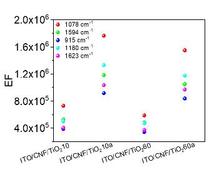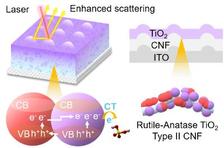This figure shows the fabrication of the titanium dioxide/cellulose nanofibril (TiO2/CNF) thin films by atomic layer deposition (ALD) and annealing. (Credit: From original publication licensed under CC BY 4.0).
Surface-enhanced Raman scattering (SERS) is one of the most efficient technology for sensing of biomolecules, trace detection of pollutants and monitoring catalytic reactions. For the fabrication of a low-cost SERS substrate with high stability and biocompatibility, semiconductor metal oxide nanomaterials (SMONs) have attracted substantial attention. Among various SMONs, titanium dioxide is an excellent candidate material as a semiconductor metal oxide-based substrate for SERS devices.
DESY’s collaboration with GSI Helmholtzzentrum für Schwerionenforschung, Darmstadt, and KTH Royal Institute of Technology, Stockholm, Sweden, is working out a novel strategy to realise the cellulose nanofibril (CNF)-directed assembly of polymorphous and homogeneous Titanium dioxide (TiO2) layer by atomic layer deposition (ALD), as is reported in the journal Advanced Functional Materials. CNFs can be fabricated into hierarchically ordered materials which provides templating architectures at multiple length scales including two-dimensional arrays and three-dimensional scaffolds; CNFs could also be used as a standard matrix for homogeneous deposition of metal nanoparticles which combines the composite films with distinct optical properties. Besides, ALD coating technique enables a well-defined thickness and the filling of deposited material into the nanometre-sized pores within the template, therefore replicates the morphology of CNFs.
The team at the P03 beamline of PETRA III, DESY, studied the influences of two key factors on the SERS performance of TiO2/CNF thin films. The first factor, the morphology of the CNF template, which regulates the ordering of the TiO2 nanostructures, is achieved via oblique incidence spraying (OIS) of CNFs onto Si and ITO substrates, respectively. The second factor, the deposited thickness of the TiO2 layer, is expected to influence the specific surface area of the layer, depending on the structural replication of the ALD coating. This influences the crystallinity of TiO2: From the grazing incidence X-ray scattering measurements we found that the specific surface area plays an important role in the crystallisation of TiO2 in addition to the annealing temperature which could be tailored through the template morphology of CNFs.
A high enhancement factor of 1.79 × 106 was achieved for the annealed TiO2/CNF thin films with a TiO2 layer thickness of 10 nm when probing 4-mercaptobenzoic acid (4-MBA) molecules, indicating a superior performance over the previously reported TiO2-based SERS substrates. There are three main advantages of our work: The bio-templated fabrication of TiO2 layer represents a promising route of layer assembly, the control over the crystallinity and morphology of the TiO2 layer is realised by the annealing and the templating conditions and the polymorphous TiO2 provides an additional electron transfer between anatase and rutile TiO2 in addition to the transfer between TiO2 and 4-MBA, therefore an excellent SERS sensitivity is obtained.
For future applications, the method of CNF-directed assembly of TiO2 layer could be advanced to a wider range of semiconductor metal oxide films. Through the combination of different deposition technologies, the templating role of CNFs could be extended to a multilayered system.
Reference:
Q. Chen, M. Betker, C. Harder, C. J. Brett, M. Schwartzkopf, N. M. Ulrich, M. E. Toimil-Molares, C. Trautmann, L. D. Söderberg, C. L. Weindl, V. Körstgens, P. Müller-Buschbaum, M. Ma, and Stephan V. Roth, “Templated Deposition of Ordered and Polymorph Titanium Dioxide Thin Films for Improved Surface-Enhanced Raman Scattering Sensitivity”, Adv. Funct. Mater. (2021) https://doi.org/10.1002/adfm.202108556









